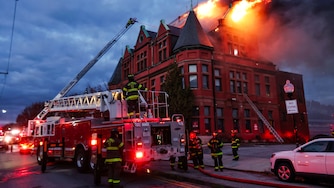Seven Marylanders have died from cold weather-related illness so far in the 2024-2025 winter season, according to the latest available data from the Maryland Department of Health.
And, with prolonged cold weather in the forecast — plus the potential for more snow later in the week — that number could increase. Baltimore has extended a Code Blue Extreme Cold alert through Saturday.
Last winter, 72 Marylanders died from reported cold-related illness; there were 51 cold-related deaths the winter before that. The cold-related deaths tracked each week are those that list hypothermia as a cause or contributing factor. In addition to hypothermia, frostbite is also an issue in cold weather, and exercising in cold weather, including shoveling snow, can cause cardiac health issues, including heart attacks.
“When we see temperatures plummet, that’s when we see more problems, everything else being equal,” said Dr. Cliff Mitchell, director of the Environmental Health Bureau with the Maryland Department of Health.
Of the seven people who died so far this season (as of Dec. 31), four of them have been older than 65 and five of them have been men. None were younger than 18.
Signs and symptoms
Hypothermia occurs when the body’s temperature falls below 95 degrees. It can affect the brain, creating extra risk as a person experiencing hypothermia may not think clearly or move well. Signs and symptoms of hypothermia, according to the CDC, include:
- Shivering
- Exhaustion
- Confusion
- Fumbling hands
- Memory loss
- Bright red, cold skin (in babies)
- Very low energy (in babies)
Hypothermia is a medical emergency, and you should seek medical help as soon as possible. Move a person into a warm room or shelter and remove any wet clothing the person is wearing.
Frostbite is an injury caused by exposure to freezing temperatures, and can lead to permanent damage and even amputation. Signs and symptoms include:
- A white or grayish-yellow area of skin
- Skin that feels unusually firm or waxy
- Numbness
If a person is experiencing frostbite but not hypothermia, get the person in a warm room as soon as possible. Unless it is absolutely necessary, do not allow the person to walk on feet or toes that have frostbite.
Put the frostbitten areas of the body in warm, but not hot, water. Use body heat if warm water is not available, but do not use external heat sources — such as a heat lamp, stove, fire or even radiator — to provide heat. Numb areas of the body can easily burn. Rubbing or massaging an area with frostbite can also cause additional damage.
Snow shoveling can be deadly
Exercising in the snow — and especially shoveling wet, heavy snow — can lead to heart attacks and other cardiac issues. Dr. Athol Morgan, a cardiologist at Grace Medical Center in Baltimore, said cold weather causes two changes in the body that can trigger a heart attack or other cardiac issue.
First, he said, is that blood vessels exposed to the cold tend to contract. Second is that cold weather makes blood more likely to clot — the blood gets thicker when people get colder. Those physiological changes, plus the added stress of intense activity, increases the odds of heart attack.
“People underestimate the amount of exertion that shoveling snow actually takes,” Morgan said. “It’s much more like going for a sprint than going for a jog.”
He said it is a “grim reality” that snow events will correlate with people going to the emergency room with a heart issue triggered by shoveling snow.
“We prepare for it, we anticipate it, and we deal with whatever comes in,” said Morgan, who is also member of the American Heart Association Baltimore & Greater Maryland Board of Directors.
The major symptoms of heart attack, according to the CDC:
- Chest pain or discomfort — most often on the left side or center of the chest
- Feeling weak or breaking into a cold sweat
- Pain or discomfort in the jaw, neck and back
- Pain or discomfort in one or both arms
- Shortness of breath
- Nausea or unexplained tiredness, especially in women
Heart issues are a medical emergency and should be treated by professionals immediately.
How to stay safe
“Preparedness is really the key to cold weather,” Mitchell said — both for individuals and communities.
For individuals, he said, it’s about knowing how to dress. For communities, it’s about knowing who your vulnerable neighbors are and having ways to check in on them.
The best way to stay safe in extremely cold temperatures is to stay indoors and avoid exposure to the cold. But if you must go outdoors, it’s important to dress properly. That includes:
- Wearing multiple layers of loose-fitting clothing
- Wearing mittens or gloves
- Wearing a hat and a scarf or mask to cover your mouth and face
- Wearing water-resistant boots
- Wearing a water-resistant coat
It’s important for people to pay attention to early warning signs, Mitchell said. Drinking alcohol or using other substances in cold weather is another risk factor, he said, because it makes you less aware of your body.
And no, despite the burning sensation when you take a sip of whiskey, alcohol does not raise a person’s body temperature, Mitchell said.
In Baltimore, a Code Blue means city-funded shelters will shelter-in-place, meaning anyone who is experiencing homelessness and wants shelter can receive it. The Salvation Army’s FeedMore mobile canteen also provides hot drinks and other cold-weather items.
The city also assists low-income households and others with paying their heating bills, applying for energy assistance and weatherizing their homes. More information on those programs can be found on the city website.




Comments
Welcome to The Banner's subscriber-only commenting community. Please review our community guidelines.